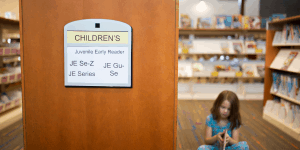Do you remember being read to as a child? Those can be some sweet memories with parents or other caregivers, snuggling up with a book and reading together. Now it’s your turn to pass on your beloved childhood favorites. And watching your child connect with the same book you loved is a unique form of the joy of reading.
The incredible thing about reading aloud together is that it connects generations to generations and allows children to foster a love of books. As a parent, you play an important role in introducing books into your child’s life. In fact, all of the bedtime stories you share over the years can help foster a lifelong love of reading and improved social skills. While research supports the many benefits of reading aloud to young children, less than half of children under age 4 are read to daily in the U.S! [1]
March is National Read Aloud month, and we encourage all parents to read aloud to their children. When you spend time consistently reading with your child, you help create a love of learning in your home. For some creative ways to make reading fun this month (and hopefully beyond), check out our suggestions below. We’ll also share more of the added benefits of reading aloud to your child.
Why Read Aloud?
More than 80% of a child’s brain is formed during their first three years, and what they experience during those years truly shapes their development. Every child needs healthy doses of physical touch, attention, and care, and one of the best ways to provide all three at once is by reading together.
Although speaking to your child about all kinds of things is good for their language development, reading does more. When you read aloud together, you build up your child’s “word bank” of vocabulary they know. You also introduce them to formal grammar and sentence structures (which might not be as apparent in our day-to-day conversation.) By reading consistently to a child, you improve their readiness to learn and give them the basic literacy skills to succeed in school.
Some of the benefits of reading aloud include:
- Language development
- Literacy skill building
- Instilling a love of reading
- Brain development
- Knowledge gained and shared
- Personal bonding
Beyond the developmental benefits, reading together also creates opportunities to connect with your child. When you take the time to read aloud to your child, you send the message that they are important and that this time is set aside especially for them. Reading is a great excuse to spend time together in a world of digital devices, and it allows you to balance the noise of the world, curled up together in the calmness of the book’s pages.
Activities For National Read Aloud Month
National Read Aloud Month is a perfect reason to read with your children at home, which is truly a gift because it brings long term benefits. Reading together helps your child’s development, and reading routines (like bedtime stories) create security and predictability for your child. Best of all, there are tons of ways you can create reading moments in your daily schedule.
Here are some ideas for celebrating National Read Aloud Month while focusing on the importance of reading aloud together:
Visit Your Local Library
Your local library is a treasure trove of reading materials where you can expose your children to more books than anyone could afford to buy! On top of that, there are tons of read aloud programs that libraries hold with special guests, librarians, and student volunteers. Regular library visits inevitably lead to more reading as children see there are so many options. To help create a long-term interest, set a limit on the number books you can check out each visit; this will keep kids excited to come back again.
Create a Reading Challenge
For some children, reading doesn’t necessarily equal excitement, so to help boost some interest you can start a family reading challenge! Create a family chart that shows the number of books you need to read for the month. You could even plan a fun activity or treat to enjoy together as a family when you hit that goal.
By creating consistent expectations for reading, you not only teach resilience to your children, but along the way you might also introduce them to books that spark a lifelong interests!
Host Bedtime Story Time
Sometimes the best time to read aloud together consistently is at the end of the day. As parents you are torn every which way, but child your always has your attention as you put them to sleep.
This is a perfect time to sneak in a book—right before bed as your child is snuggled and ready to sleep. Having time set aside for this family tradition can lead to positive memories, better sleep, and the many benefits of reading aloud.
Have Book Options Readily Available
Lastly, try to create a mini library in your home and have books readily available. Research shows that children in homes where books are readily available benefit—in terms of improved test scores—from their mere presence. And this is especially true in low-education and under-resourced homes. The research even shows that no matter how many books your home already has, every addition benefits your children even more.[2]
So whether you get them at second hand stores, check them out at the library, or buy them at bookstores, the more books you can have in your home the better! Stocking your shelves with books encourages children to explore new interests and choose reading as a pastime. Make it a habit of buying a book for holidays, birthdays, or other family events, so they are always something your children see as valuable.
Conclusion
Reading aloud and together with your child truly matters. Time you spend with your child and on their education is indispensable. Research shows children whose parents are involved in their early reading and education benefit from:
-Enhanced self-esteem.
-Improved attitude about school.
-A school to home connection
So, as you make plans to read aloud with your children more, you might need some new books, right? Below are some of our favorite children’s book you can easily introduce into your rotation:
The Book with No Pictures by B.J. Novak
The Day the Crayons Quit by Drew Daywalt
I Don’t Like Koala by Sean Ferrell
Somebody Loves You, Mr. Hatch by Eileen Spinelli
Madeline by Ludwig Bemelmans
Where the Wild Things Are by Maurice Sendak
The Monster at the End of this Book by Jon Stone
We’re All Wonders by R.J. Palacio
Life on Mars by Jon Agee
This is How We Do It by Matt Lamothe
The Hat by Jan Brett
Elmer by David McKee
A Rainbow of My Own by Don Freeman
It Looked Like Split Milk by Charles G. Shaw
Alphabet Under Construction by Denise Fleming
Rosie Revere, Engineer by Andrea Beaty
What Can You Do With an Idea by Kobi Yamada
I’m NOT Just A Scribble by Diane Alber
Lines That Wiggle by Candace Whitman
The Book of Mistakes by Corinna Luyken
The Invisible Boy by Patrice Barton
Life by Cynthia Rylant
Pass It On by Sophy Henn
Sources:
- “Fifty Top Literacy Statistics.” Ferst Readers. https://ferstreaders.org/resources/fifty-top-literacy-statistics.
- Evans, M. D. R., Jonathan Kelley, and Joanna Sikora. “Scholarly Culture and Academic Performance in 42 Nations.” Social Forces 92, no 4. (June 2014): 1576-1605. https://academic.oup.com/sf/article-abstract/92/4/1573/2235883?redirectedFrom=fulltext.



